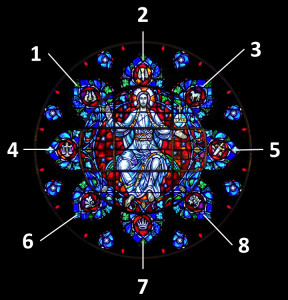The symbols in the eight petals surrounding the main circle break out into three sub-groups.
Group 1:
- Pillar of Fire. A symbol for Yahweh.
- Descending Dove. A symbol for Holy Spirit.
- Lamb. A symbol for Jesus, the perfect substitutional sacrifice for our sins.
The pillar of fire is not a common symbol. The center of this symbol has a column or pillar made up of small circles of light. My guess is that the pillar by itself wouldn’t read graphically as a pillar of fire so flames were added around the pillar to make the meaning clear. Like the PLU mandala, Group 1 gives us revelations of God covering the breadth of Scripture, Old Testament and New Testament.
Group 2:
- Scales. A symbol for the Last Judgment.
- Sword. A symbol for the Last Judgment, martyrdom, etc.
Scales together with a sword most likely refer to the Last Judgment and are often shown in art together with the Arch Angel Michael. (Hans Memling’s triptych painting of the Last Judgment is a good example.) In this image the scales are empty and the sword is broken. My interpretation of Group 2 is that we are intended to look forward to a period of Christ’s glorious reign after the Last Judgment has taken place.
Group 3:
- Lily or Fleur-de-lis. A symbol for purity, royalty, or the Trinity.
- Crown. A symbol for royalty, the office of a king.
- Laurel. A symbol for triumph and eternity.
Group 3 simply celebrates the eternal, glorious, reign of Christ with his bride the Church. This re-enforces the overall theme of the mandala.
The symbols in the eight petals surrounding Christ simply re-enforce this central point.
In Part 5C we will return to the number eight which is very prominent in the image and take a closer look at a few more subtle symbols in the image.

